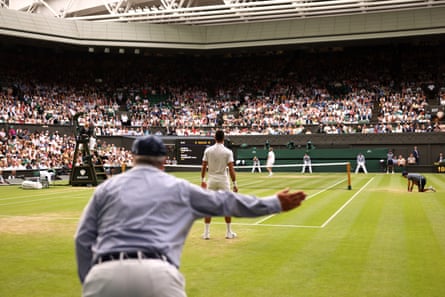The greatest tennis players in the world will be left to rage against a machine after any tight line calls at Wimbledon next year as the All England Club will break with tradition by removing line judges from all courts during the championships for the first time in its 147-year history.
From 2025 onwards live electronic line calling (ELC) will be used on all courts in both the main draw at the All England Club and the qualifying tournament off-site in Roehampton. The new technology was successfully tested during this year’s championships.
Wimbledon’s chief executive, Sally Bolton, said: “The decision to introduce Live Electronic Line Calling at the championships was made following a significant period of consideration and consultation.
“Having reviewed the results of the testing this year, we consider the technology to be sufficiently robust and the time is right to take this important step in seeking maximum accuracy in our officiating.
“For the players, it will offer them the same conditions they have played under at a number of other events on tour.”
While the move represents a historic change for the tournament, it also simply reflects the direction that the rest of the sport has been moving in for some time.
Wimbledon took its first step towards line-calling technology when it adopted Hawk-Eye technology 17 years ago for the 2007 tournament. Hawk-Eye and various other line review systems have long been present at most tournaments, offering players the opportunity to review line-calls through “challenges”, with the electronic review system having the final authority in line calls.
As tennis tournaments returned following the pandemic hiatus in 2020 and attempted to continue through Covid restrictions and social distancing regulations, some of the biggest, including the 2020 US Open, began to adopt ELC on a limited number of courts.
In the intervening years, ELC has become prevalent around the world and the consensus in tennis is that it has allowed for quicker and more accurate decisions. The top players have quickly adjusted to the new normal and there are far fewer contentious calls when it is in place.

The Australian Open became the first grand slam tournament to be held without line judges on any court and the US Open opted to remove line judges in 2022. Last year, the ATP announced that ELC would be adopted at all ATP Tour events on every court from 2025 onwards. Wimbledon’s announcement leaves the French Open as the only grand slam tournament tournament yet to commit to ELC.
after newsletter promotion
There are, however, concerns over the disappearance of line judges from the highest levels. Some miss the greater human presence on-court, with both positive and negative interactions between players and officials adding to the spectacle, while the electronic review system often added to the suspense and tension during a match.
Most importantly, the culling of 300 line judges means fewer part-time opportunities for trained officials and it will affect the pathway of aspiring chair umpires. Many chair umpires started off as line officials.
“We understand the reasons behind the decision to introduce live electronic line-calling and we recognise the ongoing changes to officiating around the world,” said the LTA in a statement. “With this in mind we are already working with the Association of British Tennis Officials to understand the impact on the pathway for British officials, and develop a new joint strategy with them that will ensure officials can be retained within the sport, new officials can be recruited and the officiating community will be supported through the changes.”
Additionally, the All England Club announced a significant change to the scheduling of the tournament’s final weekend. The singles finals have traditionally started at 2pm but from next year, both the women’s and men’s singles finals on the second Saturday and Sunday will be moved to 4pm. The changes will provide a better viewing window for North and South American viewers and the women’s final, along with the men’s final, will now be the last match of the day.
Source: theguardian.com


















